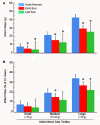Infarct healing is a dynamic process following acute myocardial infarction
- PMID: 22937750
- PMCID: PMC3443460
- DOI: 10.1186/1532-429X-14-62
Infarct healing is a dynamic process following acute myocardial infarction
Abstract
Background: The role of infarct size on left ventricular (LV) remodeling in heart failure after an acute ST-segment elevation myocardial infarction (STEMI) is well recognized. Infarct size, as determined by cardiovascular magnetic resonance (CMR), decreases over time. The amount, rate, and duration of infarct healing are unknown.
Methods: A total of 66 patients were prospectively enrolled after reperfusion for an acute STEMI. Patients underwent a CMR evaluation within 1 week, 4 months, and 14 months after STEMI.
Results: Mean infarct sizes for the 66 patients at baseline (acute necrosis), early follow-up (early scar), and late follow-up (late scar) were 25 ± 17 g, 17 ± 12 g, and 15 ± 11 g, respectively. Patients were stratified in tertiles, based on infarct size, with the largest infarcts having the greatest absolute decrease in mass at early and late scar. The percent reduction of infarct mass was independent of initial infarct size. There was an 8 g or 32% decrease in infarct mass between acute necrosis and early scar (p < 0.01) with a 2 g or 12% additional decrease in infarct mass between early and late scar (p < 0.01).
Conclusions: Infarct healing is a continuous process after reperfusion for STEMI, with greatest reduction in infarct size in the first few months. The dynamic nature of infarct healing through the first year after STEMI indicates that decisions based on infarct size, and interventions to reduce infarct size, must take into consideration the time frame of measurement.
Figures



Similar articles
-
High-sensitivity troponin T predicts infarct scar characteristics and adverse left ventricular function by cardiac magnetic resonance imaging early after reperfused acute myocardial infarction.Am Heart J. 2015 Oct;170(4):715-725.e2. doi: 10.1016/j.ahj.2015.06.022. Epub 2015 Jul 2. Am Heart J. 2015. PMID: 26386795
-
Left ventricular functional recovery of infarcted and remote myocardium after ST-segment elevation myocardial infarction (METOCARD-CNIC randomized clinical trial substudy).J Cardiovasc Magn Reson. 2020 Jun 11;22(1):44. doi: 10.1186/s12968-020-00638-8. J Cardiovasc Magn Reson. 2020. PMID: 32522198 Free PMC article. Clinical Trial.
-
Relative role of NT-pro BNP and cardiac troponin T at 96 hours for estimation of infarct size and left ventricular function after acute myocardial infarction.J Cardiovasc Magn Reson. 2007;9(5):749-58. doi: 10.1080/10976640701544589. J Cardiovasc Magn Reson. 2007. PMID: 17891611
-
Impact of left ventricular hypertrophy on myocardial injury in patients with ST-segment elevation myocardial infarction.Clin Res Cardiol. 2018 Nov;107(11):1013-1020. doi: 10.1007/s00392-018-1273-8. Epub 2018 May 16. Clin Res Cardiol. 2018. PMID: 29766285 Clinical Trial.
-
Infarct-related artery patency and long-term effects on left ventricular remodelling.Cardiology. 1997;88 Suppl 1:26-35; discussion 36. doi: 10.1159/000177456. Cardiology. 1997. PMID: 9118165 Review.
Cited by
-
Review of Journal of Cardiovascular Magnetic Resonance 2012.J Cardiovasc Magn Reson. 2013 Sep 4;15(1):76. doi: 10.1186/1532-429X-15-76. J Cardiovasc Magn Reson. 2013. PMID: 24006874 Free PMC article. Review.
-
Changes in remote myocardial tissue after acute myocardial infarction and its relation to cardiac remodeling: A CMR T1 mapping study.PLoS One. 2017 Jun 23;12(6):e0180115. doi: 10.1371/journal.pone.0180115. eCollection 2017. PLoS One. 2017. PMID: 28644903 Free PMC article.
-
Peak CK-MB has a strong association with chronic scar size and wall motion abnormalities after revascularized non-transmural myocardial infarction - a prospective CMR study.BMC Cardiovasc Disord. 2018 Feb 8;18(1):27. doi: 10.1186/s12872-018-0767-7. BMC Cardiovasc Disord. 2018. PMID: 29422025 Free PMC article.
-
Prognostic value of left ventricular global function index in patients after ST-segment elevation myocardial infarction.Eur Heart J Cardiovasc Imaging. 2016 Feb;17(2):169-76. doi: 10.1093/ehjci/jev129. Epub 2015 Jun 7. Eur Heart J Cardiovasc Imaging. 2016. PMID: 26056134 Free PMC article.
-
Hydrojet-based delivery of footprint-free iPSC-derived cardiomyocytes into porcine myocardium.Sci Rep. 2020 Oct 8;10(1):16787. doi: 10.1038/s41598-020-73693-x. Sci Rep. 2020. PMID: 33033281 Free PMC article.
References
-
- St John Sutton M, Lee D, Rouleau JL, Goldman S, Plappert T, Braunwald E, Pfeffer MA. Left ventricular remodeling and ventricular arrhythmias after myocardial infarction. Circulation. 2003;107:2577–82. - PubMed
-
- Lund GK, Stork A, Muellerleile K, Barmeyer AA, Bansmann MP, Knefel M, Schlichting U, Müller M, Verde PE, Adam G, Meinertz T, Saeed M. Prediction of left ventricular remodeling and analysis of infarct resorption in patients with reperfused myocardial infarcts by using contrast-enhanced MR imaging. Radiology. 2007;245:95–102. doi: 10.1148/radiol.2451061219. - DOI - PubMed
-
- Hombach V, Grebe O, Merkle N, Waldenmaier S, Höher M, Kochs M, Wöhrle J, Kestler HA. Sequelae of acute myocardial infarction regarding cardiac structure and function and their prognostic significance as assessed by magnetic resonance imaging. Eur Heart J. 2005;26:549–57. - PubMed
Publication types
MeSH terms
LinkOut - more resources
Full Text Sources
Medical

